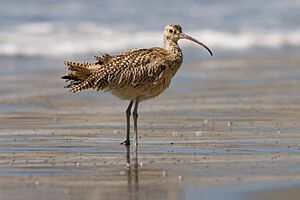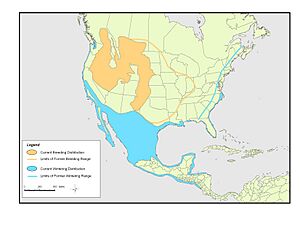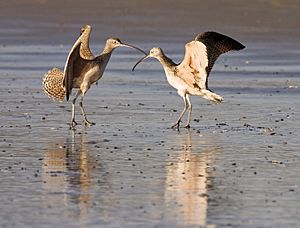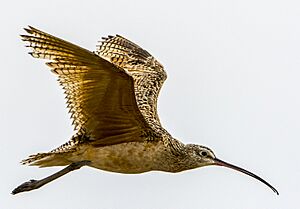Long-billed curlew facts for kids
Quick facts for kids Long-billed curlew |
|
|---|---|
 |
|
| Conservation status | |
| Scientific classification | |
 |
|
| Range of N. americanus | |
| Synonyms | |
|
Numenius longirostra(is) |
The long-billed curlew (Numenius americanus) is a large North American shorebird. It belongs to the family called Scolopacidae. People used to call this bird the "sicklebird" or the "candlestick bird." These birds breed in the middle and western parts of North America. They then migrate south and towards the coast for winter.
Description
The long-billed curlew is the biggest sandpiper you'll usually find in North America. It is about 50 to 65 centimeters (20 to 26 inches) long. Its wingspan can be from 62 to 90 centimeters (24 to 35 inches). This bird weighs between 490 and 950 grams (1.1 to 2.1 pounds).
Its very long bill curves downward. This bill can be from 11.3 to 21.9 centimeters (4.4 to 8.6 inches) long. It's one of the longest bills of any shorebird. Curlews have a long neck and a small head. Their neck and belly are a light cinnamon color. The top of their head has brown streaks. Female curlews are usually larger than males. They also have a much longer bill. This is called sexual dimorphism.
Reproduction

Long-billed curlews breed in the grasslands of west-central North America. They perform a special dance to find a mate. They also fly in fast, looping patterns to attract partners.
Their nest is a small hollow in the ground. They line it with weeds and grasses. Female curlews lay four eggs. The eggs can be white to olive in color. Young curlews are precocial. This means they can leave the nest soon after hatching. Both parents care for the young birds at first. However, females often leave the chicks with the male after 1 to 3 weeks. They then fly to their winter homes.
Feeding
Long-billed curlews often feed together in groups. They use their long, curved bills to search for food. They probe the mud or sand to find tasty meals. Their usual diet includes crabs and other small creatures without backbones. They also eat grasshoppers, beetles, and other insects. Sometimes, these birds have been seen eating the eggs of other birds.
Conservation Status
The number of long-billed curlews dropped a lot in the late 1800s. This was mainly due to hunting. However, their numbers have grown back somewhat more recently. The IUCN (International Union for Conservation of Nature) once listed them as "Near Threatened." This meant they were close to being endangered. But new studies showed that the long-billed curlew is now common again. So, in 2008, their status was changed to "Least Concern." This means they are not currently at risk.
Candlestick Point in San Francisco was named after this bird. Later, the Candlestick Park stadium got its name from the point. By the early 1900s, the curlew population in San Francisco had greatly declined. By the time the stadium was built in the 1950s, the large groups of "candlestick birds" were gone.
Long-billed curlews also used to spend winters on the East Coast. The famous artist John James Audubon painted these birds near Charleston, South Carolina. But hunting and loss of their breeding areas almost wiped out this population. Today, only a small group of fewer than a hundred birds still winters on the East Coast. This group has not yet fully recovered. In 2015, one of these "ghost birds" was caught off the coast of Georgia. It was given a satellite tag to track its migration. It began its flight in April 2016.





